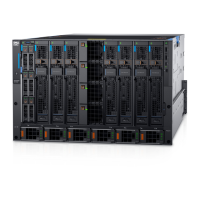Scalable Fabric restrictions and guidelines
The following restrictions and guidelines are in place when building a Scalable Fabric:
• Mixing IOM types in the same Scalable Fabric (for example, MX9116n FSE in fabric
slot A1 and MX5108n in fabric slot A2) is not a supported configuration.
• All MX9116n FSEs and MX7116n FEMs that participate in a Smart Fabric must be
in MX7000 chassis that are part of the same MCM group.
• When using both Fabric A and B for a Scalable Fabric Architecture, the following
restrictions apply:
▪ IOM placement for each fabric must be the same in each chassis. For instance,
with an MX9116n FSE in fabric slot A1, the second MX9116n FSE should be in
fabric slot B1.
▪ Chassis 3 through 10, that only contain MX7116n FEMs, connections must be
made to the MX9116n FSE that is in the same slot and in the same MCM
chassis group.
• Interconnecting switches in A1/A2 with switches in B1/B2, regardless of chassis, is
not supported.
• When operating with multiple chassis, switches in A1/A2 or B1/B2 in one chassis
must be interconnected only with other A1/A2 or B1/B2 switches respectively.
• Create symmetrical uplinks. For example, if one MX9116n FSE has two uplinks, the
other MX9116n FSE must have two uplinks of the same speed.
• Enable LACP on upstream switches. LACP is required on the connected port
channel.
• Ensure that switches in SmartFabric mode do not link to another pair of switches in
SmartFabric mode. However, a SmartFabric can uplink to a pair of switches in Full
Switch mode.
The table below outlines the recommended port order for connecting chassis with
MX7116n FEM modules to the MX9116n FSE to optimize buffer utilization. Table 6
references IOMs in Fabric A, but the same guidelines apply to IOMs in Fabric B.
Table 6. Recommended PowerEdge MX7000 chassis connection order

